If you are looking to master Malayalam, then this is the blog post for you. We have compiled a list of resources that will help you pick up Malayalam from scratch or brush up on your skills. You will find that taking up a new language can be an enriching and valuable experience. I hope this article helps.

Learn Malayalam Yourself
What is the Malayalam language?
Malayalam ( മലയാളം, maləyōḷ) is a Dravidian language spoken in the Indian state of Kerala and the union territories of Lakshadweep and Puducherry (Mahé) by the Malayali people. It belongs to the Indo-Aryan branch of the Indo-European languages. Malayalam has official language status in the state of Kerala and in the union territories of Lakshadweep and Puducherry (Mahé). According to an estimate, it is used by 38 million people, making it among one of the most widely spoken Dravidian languages.
Malayalam has been preserved for at least a thousand years. Linguistic scholars classify Malayalam as a central Dravidian language, although it is often placed independently within the Dravidian family. It is written using the Malayalam script, an alphabet conceived in the 7th century by the sage Parāśara and modified over time.
Vernacular dialects occasionally show influence from Sanskrit, Tamil, Hindi, or Arabic.
Malayalam shares a lack of grammatical gender with other Dravidian languages and an emphasis on word order to convey meaning (instead of inflection). A distinctive feature of Malayalam is its use of lexicon-intensified verbs—verbs that are intensified due to greater concentration or density of meaning, with uncommon grammatical forms and periphrastic verb conjugations.
Malayalam is a language rich in written literature: the earliest Malayalam inscriptions date from about 830 AD, and many literary works in the Western classical tradition have been translated into Malayalam from English and 18th-century Sanskrit. In 1981, Indian National Theatres started its annual drama festival, the ‘Vallathol Narayana Menon Awards’ for lifetime achievements in theatre was instituted by the University of Kerala in 1971 renamed after playwright Vallathol Narayana Menon (1878–1958).
Benefits of learning Malayalam for non-native speakers
Apart from a great feeling of achievement, here are some more reasons why you should pick up Malayalam:
Rich in Literature
The early literature of Malayalam includes a group of Sanskrit dramas written between the 8th and 11th centuries, Chakyar koothu ( Hindu shadow puppet theatre), numerous proverbs, and folk songs. These works form the basis for modern prose and poetry. A lot of early work was destroyed during invasions from neighboring states or communities like Tippu Sultan, who invaded Kerala a few times during the 18 century to take over complete control in Bharat.
Later, the British historian Robert Caldwell published his study on the language, History Of Literature In Southern Travancore, starting from the 19th century. Apart from a few inscriptions or poems, there is little extrinsic evidence for literature in Kerala until the 9th century.
The earliest literature of Malayalam comprised three genres: poetic, religious, and secular, and non-literary forms such as proverbs. The songs were called Thullal, cheruthuruttu Vritham, Chakyar koothu, and so on.
The birth of Malayalam cinema has helped to spread the popularity of this language because many movies are made in this language which people enjoy watching around the world because it gives them some idea about the lifestyle of people living in Kerala who use Malayalam. Malayalam films have won 4 National awards since 1969 for Best Feature Film and another 12 Best Feature Film awards at the State level, along with many Special Jury Awards.
Malayalam is also spoken on the west coast of South India, especially Kerala (also known as Keralam), Lakshadweep Islands, and States like Karnataka. Outside Bharat, it is spoken by Indian communities residing in Qatar, Fiji, and other Gulf countries; Eastern Africa (Kenya, Tanzania); United Arab Emirates; European countries including Britain, Denmark, France, Germany, etc., Malaysia, Singapore, Maldives Oman Ethiopia Yemen United States of America And Canada, etc.
It has a very rich vocabulary.
The Malayalam language is also known as ‘the language of the Gods’ and here’s why: Sanskrit was the medium of education during much of Kerala’s history, the vocabulary/pronunciation and phrases from this ancient language are part of Malayalam’s everyday speech. Hinduism greatly influenced Malayalam parlance. Around 70% of Hindus live in the Malabar region, where Malayalam is predominant.
This language is called mother tongue for 75% of people who use it because it is not just for conversation but used in almost all types of communication like song lyrics, poems, stories, etc., which will give you an idea about the richness and variety of word usage when compared to any other languages available today. Knowledge of this language will give you an edge over many others.
Extend your Horizons
Nowadays it’s cool to know languages and use them casually even with friends who converse in that particular one also. It was definitely possible till a few years back, but now people really appreciate the efforts taken by anyone towards picking up a new language word, so recognizing their effort would definitely enrich your friendship. These days being multilingual has become common, so why be left behind? Not just working knowledge is enough but you should be able to converse fluently.
Improve Communication with Natives
Malayalam today is the official language of the state of Kerala and one of the 22 national languages recognized by the Indian constitution. You will also find Malayalam spoken in Lakshadweep islands which Maharajas ruled from 1820-1956.
Apart from that, it’s spoken in various parts throughout Bharat and abroad. Malayalam was used to communicate between people on different sides of this region during wartime or other interregnum periods when other languages might have been seen as more suspicious. It’s like picking up any regional language word would give you an opportunity to communicate much better with people around and a hence good chance of success in a multi-cultural environment.
Enhance Literature
If you love exploring Kerala literature, mastering Malayalam would be a good idea. Most of the classic literary works are written in this language, so getting well-versed in it will aid you to much better apprehend how people think and plan things around their language and culture.
Many scholars studying Vedic history, Sanskrit rules, or Indian philosophy used to master Malayalam for extensive research purposes, which were available only in this language only before English versions became popular these days.
Bilingual
In some ways, becoming bilingual can really make life much easier since there are many places you could go to where knowing both languages would give you an advantage over others (especially if they don’t understand any other language and you or your current colleagues converse in that particular one). One of the best examples is Bharat since Hindi, Urdu, Punjabi, Bengali are spoken by much of it’s people, but how much they apprehend about their own script system is a different story. A similar situation exists in Singapore, where communities from Kerala state love to use Malayalam and Tamil.
Why learn the Malayalam language?
a) Have you ever thought while watching a movie, reading a book or word, or listening to a song that you wish you understand the language? It gives you an opportunity to apprehend things much better and love them more.
b) If your profession or hobby involves frequent travel to Kerala, knowing Malayalam can be useful so that one day when they come across someone from Kerala, they will not feel awkward when communicating with them, unlike others who will speak and answer only in English due to their ignorance about this regional language. They might even end up insulting someone by unknowingly referring to something inconsistent in Malayalam than what was understood as intended, which is very much possible till today since there are quite some people with levels of education varied between 0-12+ years who still feel they are more superior than others and can discuss anything better in English. This is very common among various communities, including Syrian Christians, Nairs, Nambiar’s, Masons, etc.

c) Being able to communicate effectively with guys whom you meet around you might aid to resolve issues fast and easily without giving them that feeling of “I have a headache now due to the language barrier.”
This is especially useful when your current job requires frequent interactions with people of varying cultures from various regions or professions who speak this regional language and being able to converse with them will bring out a number of hidden opportunities for sure.
d) If you have a love for Kerala history, literature, or philosophy, there’s no way you avoid the Malayalam dialect. For example, during ancient times, Keralites were great in poetry and writing, which are still there to be seen in the form of different types of literature available today, including Alankarams, Padyams, etc.
Apart from that, one of the greatest works on Sanskrit grammatical rules is written by Maharshi Bharadwaaja himself, who lived somewhere between 500 BC-300 AD whose original work “Vyakaranam” was done in Malayalam before it got translated into other languages as well.
Even some of the Vedic treatises like Taittiriya Aranyaka (section 5 ) and Chandogya Upanishad contain references to this region, indicating its existence even thousands of years ago. Works like these wouldn’t have been possible without Malayalam.
Knowing this language can open a lot of opportunities for researchers as it’s said that various Vedic scholars used to pick up Malayalam in ancient times rather than Sanskrit because there were a lot of text versions available then compared to Sanskrit, which was mainly written on palm leaves in those days.
So, if you are ever interested and searching for original manuscripts or works related to such events, this language could be quite useful.
Most important features of the language
a) It is one of the few languages in Bharat which have both vowel and consonant harmony. This concept can be quite interesting to follow. To explain this, let’s take a look at some Malayalam words:
i) അ -(A): The dotted “a” means that it should be pronounced as a part of Vowel Harmony, while the dotted underline indicates that it is more closer to Palatal Service (a palatal approximate”).
ii) ക – (Ka): The square bracketed “ka means that it should be pronounced as part of Consonant Harmony while the squared underlined letter represents its nature as Velar approximate (a velar stop).
iii) മ – (Ma): The circle bracketed “ma indicates that it is a glide while the circled underlined letter represents its nature as Palatal approximate (a palatal vocoid).
iv) ത – ((Ta): The triangle bracketed “ta means that it should be pronounced as part of Consonant Harmony, and the triangle underlined represents a dental approximate.
b) It can produce consonants in 4 manners with 5 different plosive articulations:
Velar, Uvular, Palatal, Retroflex, and Dental. This comes out to 10 unique sounds, which are further classified into 19 consonants or 16 primary and 3 secondaries.
c) It can produce vowels in 5 manners with 9 varying articulations: Close, Mid, Open-Mid, Open and Nasal.
This comes out to 45 unique sounds or 35 primary plus 10 secondary sounds (again plus two more which will be added later).
d) Three varying forms of writing Malayalam were created by the Christian missionaries
i) Vattezhuthu: was based on the script used for the Syriac Aramaic version of the Bible
ii) Grantha-Malayalam: was similar to Grantha script
iii) Kolezhuthu: written slightly differently from modern times.
e ) Malayalam has three varying phonetic alphabets, namely
i) Todaram: used in the northern part of Kerala, mainly in Kannur and Kasaragod regions
ii) Grantha-Malayalam: used in central Kerala
iii) Kolezhuthu: used in southern Kerala
f ) It has 12 vowels (9 plus 3 more added latter), 9 diphthongs (6 plus 3 more added later), 21 consonants (19 plus 2 new ones mentioned above) , 33 Vyanjanams/Morphophonemics(21+12), 36 Sandhis/Gemination (21+15) .
g ) The grammatical rules of this language are called the Dravidian framework and are one of the most complex in Bharat. But that’s what makes it so interesting.
h ) Here are some more features to know about Malayalam :
i) It has got its own inherent script.
ii) It can be written using English letters as well (this is mainly used by those who want to send SMS or MMS since phone keyboards don’t have all the characters available).
iii) Numbers follow a peculiar pattern which goes like 1,2,3…..10,20…100 up to 1000…10000….1000000….etc..and then starts again with 100000 +1 …(one thousand and one)…1000000+2……..(one billion one)…etc.
iv ) Dates are written in the format of year, month, and day like 2013-06-14 for the date 14th June 2013
v ) It is an SVO language (like English, Sanskrit, etc.), meaning that sentences have a subject (S), verb (V), and Object (O).
vi) Word order is not really important while forming sentence structures. So almost all combinations go with it.
vii) Tense markers will occur at the end of a verb or close to it, typically followed by particles denoting time reference. This means that tense has more to do with the number of times an action occurs than where it occurred when.
viii ) The language has 3 genders which are masculine, feminine, and neuter. Each gender can have its own set of vowels and consonants.
ix) In Hinduism, the language is considered sacred. So there is a book called “Narayaneeyam,” which has been written in Malayalam.
x) There are 8 moods in this language:
Indicative, Optative (used as subjunctive), Imperative, Subjunctive, Jussive (used as imperative), Desiderative (used as a wish or request), Potentive and Dubitative.
xi) There are 11 tenses:
Present tense, Past definite tense, Past indefinite tense, Future tense/future simple tense, Past conditional tense, Future conditional tense, Past presumptive tense, Future presumptive tense, Imperfective and Perfective.
xii) There are 13 cases:
Nominative (subject), Accusative (object of the direct object), Instrumental/Dependent( used to express something through itself rather than a noun or pronoun.), Ablative( expresses a separation from something ), Adessive/Allative( for showing location ), Genitive/Possessive( shows possession or ownership), Comitative( with ), Locative( in the place of ) Cessation (used to express cessation or completion ), Essive (to be as), Evidentiary (for indication)
How to get started with Malayalam?
a) Get a good Malayalam dictionary (or get an online translation software to work as your dictionary).
There are also quite some free sites on the internet which contain almost all the vocabulary/pronunciation and phrases. Make a routine to memorize a few words daily.
b) Find and download some practice material/software/app and start picking up this language.
There is plenty of youtube videos, apps, translation software, and websites on the Internet that can be used easily for self-study purposes. Just type in keywords like grasp Malayalam etc..and you will find a lot of options available out there.
c) Find some friends with whom you can make yourself comfortable to practice speaking the language, exchange notes, or just voice out your questions regarding grammar, etc.
d) Be regular, persistent, and patient like elsewhere; mastering any new language will be a challenge. But it’s all worth the effort(and fun) in the end.
d) Audio-visual materials are best to comprehend the vocabulary, pronunciation plus phrases, and their usage, so you can go for online video sites/apps that contain videos or short lessons about the topics you need to master.
You can also search and find YouTube channels/apps related to grasping Malayalam.
e) Try speaking with local / near-native speakers as much as possible so that they could guide you on a lot of things including pronunciation. Male a routine for doing so.
Resources For Learning The Language
A great Malayalam dictionary is always a must-have for any learner irrespective of the local language because it is difficult to find one without spending lots of bucks.
You can refer to online translators/apps at times, but I suggest you just find yourself a good dictionary if you really like the Malayalam language and want to master it.
1. There are many tools available online:-
a) Youtube
Youtube app has plenty of video course on basic Malayalam pronunciation with captions available in various languages. This is the best source for self-learners.
You can go through and find a lot of video clips on the YouTube app, and you can also make your own questions by searching a specific topic like how to say “How are you?” or “I am fine” in Malayalam, and then type the words in google search. A number of video channels will be found showing these phrases as well as other useful vocabularies and phrases.
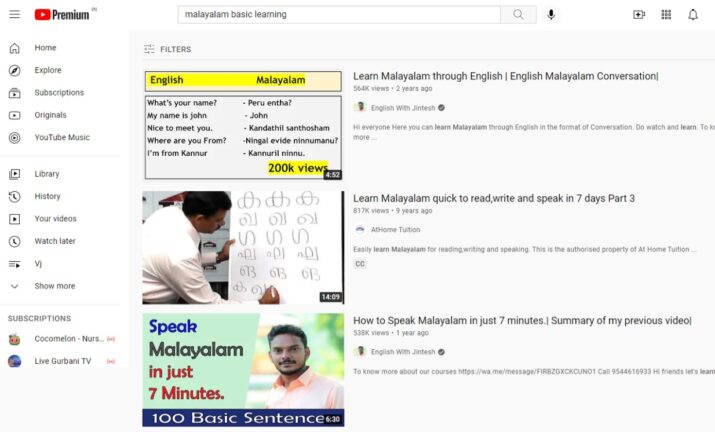
b) Mango Language Platform
UC Browser has partnered with the platform to provide Malayalam language lessons to users of UC Browser 7 to access its Malayalam course on their mobile phones.
The course for learning Malayalam is enabled by UC Browser covers over 75 topics across four levels. Topics covered include greetings, introductions of yourself and others, everyday phrases related to traveling and socializing.
You can make the UC browser your home page and access the courses directly from there or from the app, allowing users to pick up Malayalam and try conversing at their pace within the Mango app user interface.
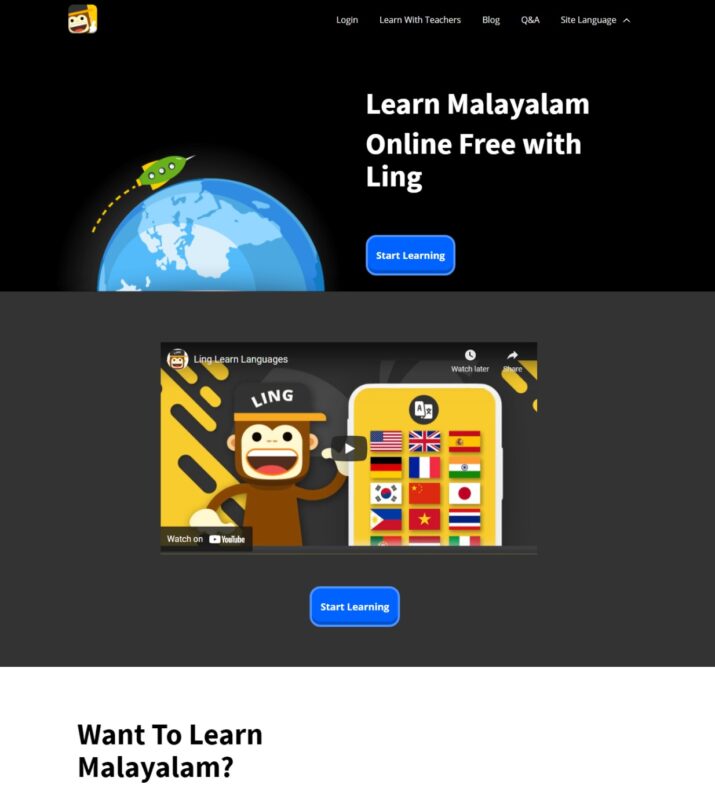
c) Linguashop
This website and app are based on an Android app for picking up Malayalam through an interactive interface. The App can be downloaded from the google play store or any other store.
Apart from providing useful information about the Malayalam language, the app make available live chat services with local speakers as well as voice search to grasp new vocabulary easily and quickly with fun.
It also lets you review and test your skills when you answer them.

d) Malayalam Keyboard for Android
This app is designed to work with android devices and tablets that have an Indian keyboard enabled to write.
You can use the app in conjunction with the Google voice input so that you can speak your vocabulary or sentences to write automatically into Malayalam or any other Indian language script on your device. It lets you make notes.
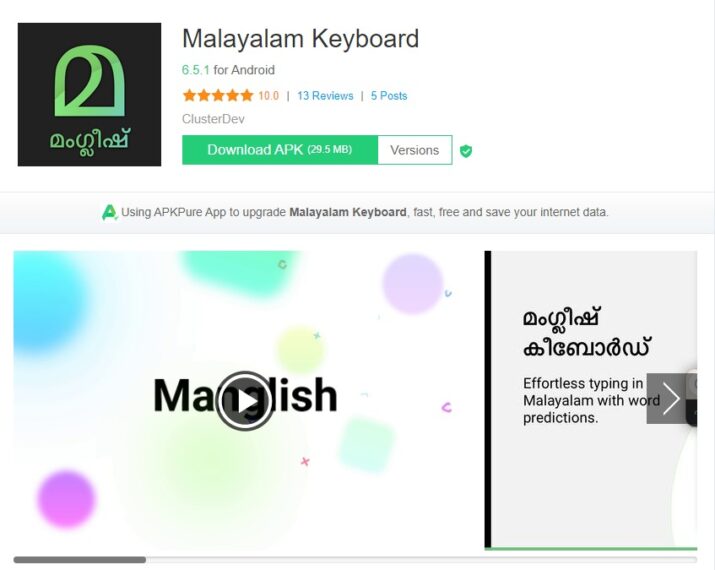
e) Udemy
There are a number of courses available on this app for Malayalam. You can grasp all the basics of Malayalam script and also some advanced grammar topics in just 30 days without paying.
You can also test review your knowledge through assignments and make notes.
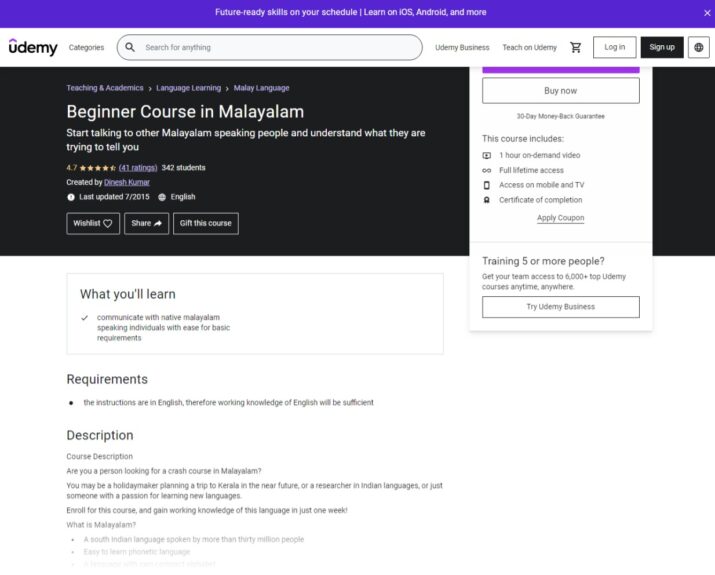
f) Word Reference
This is a very useful website to try that provides various examples of grammar with a detailed description. It has an active forum where you may ask relevant doubts.
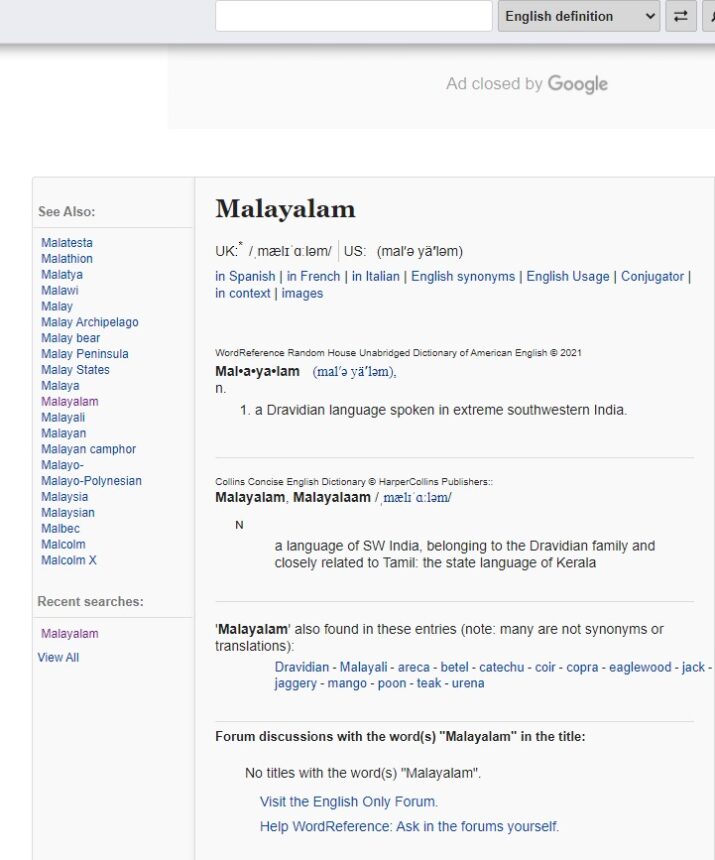
g) Mylanguageexchange.com
The course is scheduled in several phases. Topics covered in the Malayalam course are syllabic consonants, vowels, and anusvara, visarga; numbers up to 999; days of the week; dates; months, etc.
This can make you grasp the basics easily.
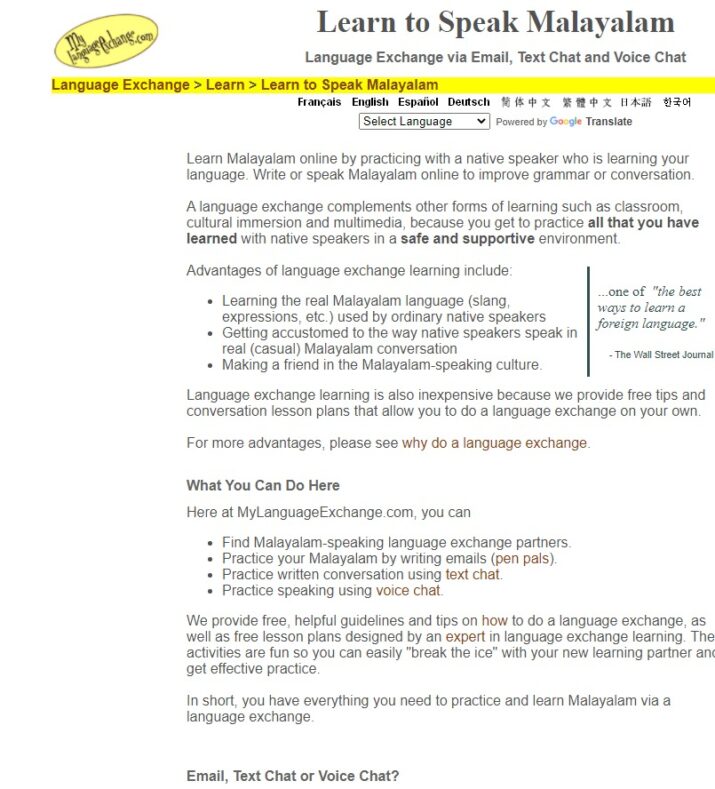
h) Memrise
This site and app also provide various comprehensive courses on various dialects ( Malayalam included), which you can try both without paying any money and also have a paid subscription plan (both monthly and yearly).
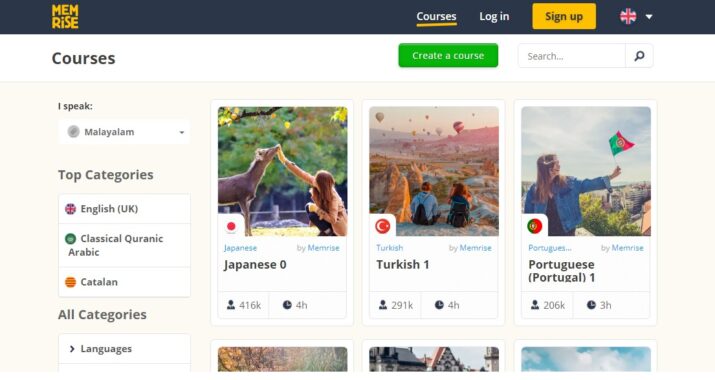
i) Cudoo
This is a great site to try for learning Malayalam basics. It also has some links on youtube with a short video course to help make learning Malayalam easier.
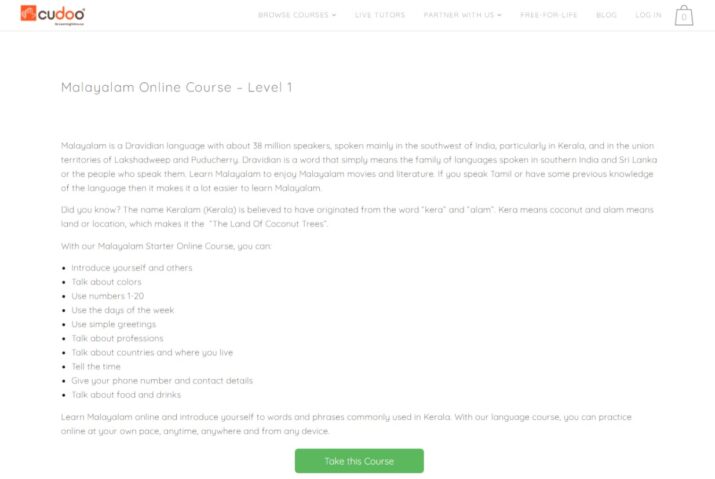
j) Netflix
There are a number of audio and video course available on the Netflix app that you can try. You can create your own account without any charges.
If you have a high-speed Internet connection, this is a great way to master Malayalam as it provides you with content on a familiar app interace, which you can access from anywhere in the world using any portable device connected to the internet.
This is a great source to pick up Malayalam through various cartoon shows and feature movies that have been dubbed into Malayalam.
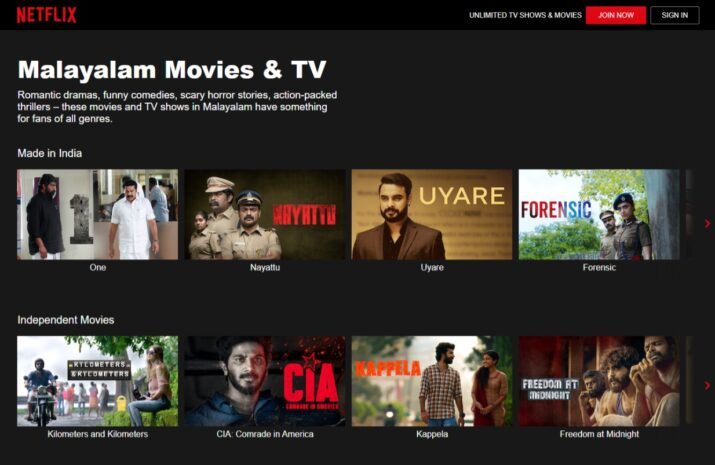
k) BMOOC Bhoomi Malayalam
This site and app provide short information about Malayalam in very simple terms. You can also click on the links provided in the left side menu bar to read Free dictionary.
You get to comprehend Tamil meaning of Malayalam words, Verbs conjugation, understanding declensions, and other useful topics.
It has PDF format of a lot of books that you can read without paying any money, although there are some books with charges as well.
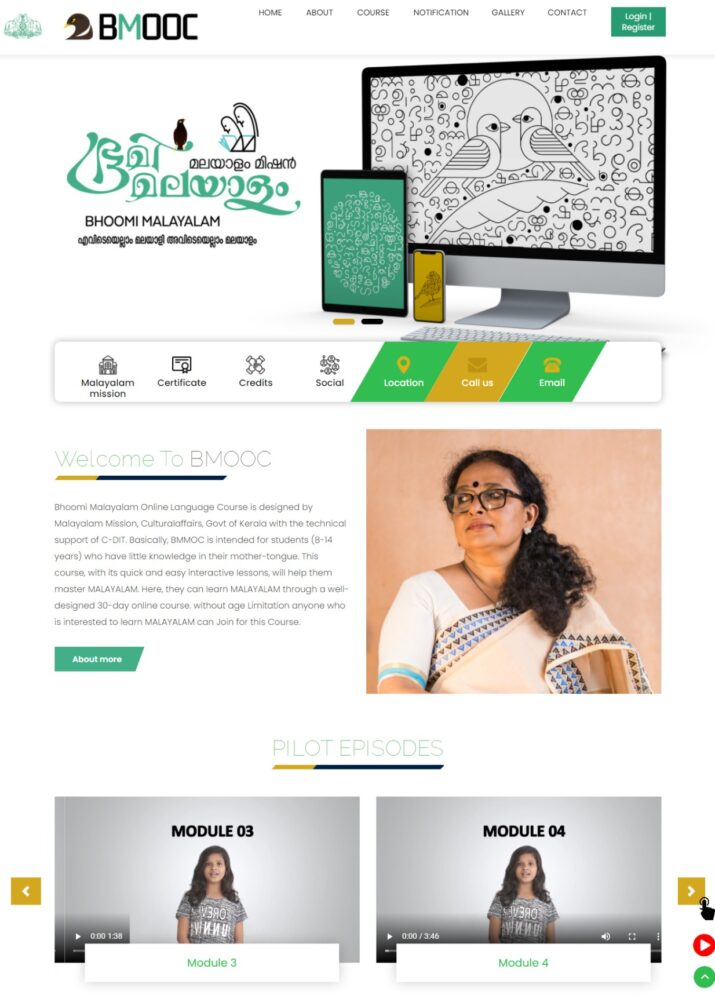
l) Ling App
The app has a Malayalam course (Intermediate level) available as a part of their learning Malayalam suite. You get video clips from TV channels and movies that you can try for learning Malayalam.
The user learns by viewing these clips and listening to dialogues or conversations related to an activity shown in action in the video clip.

m) Malayalam Wiki
Another resource you can try is Wikipedia’s Malayalam version. It has a lot of information and links that open up windows for your learning. You can even use it to brush up on some grammar as well.
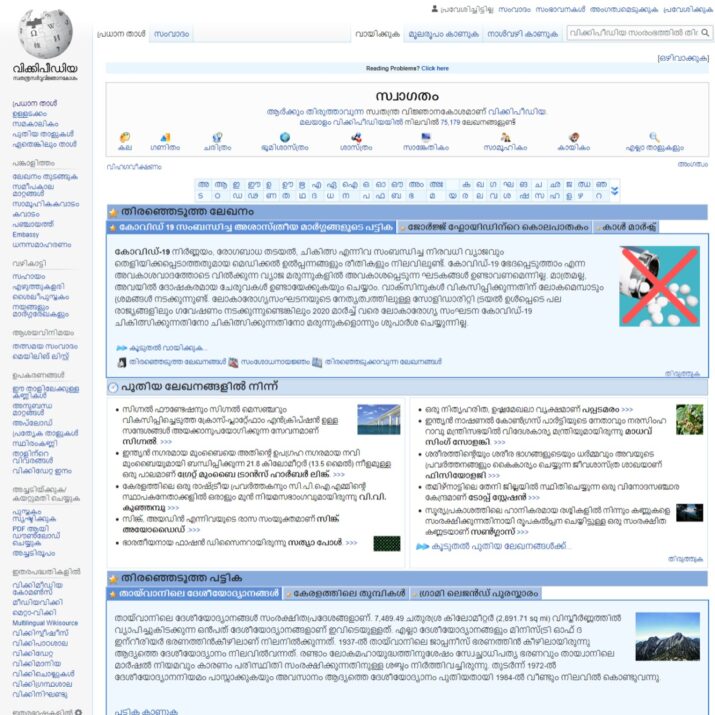
n) Learn_Malayalam
This is an Android App available at no cost from Google Play, which is very useful for beginners that you can try.
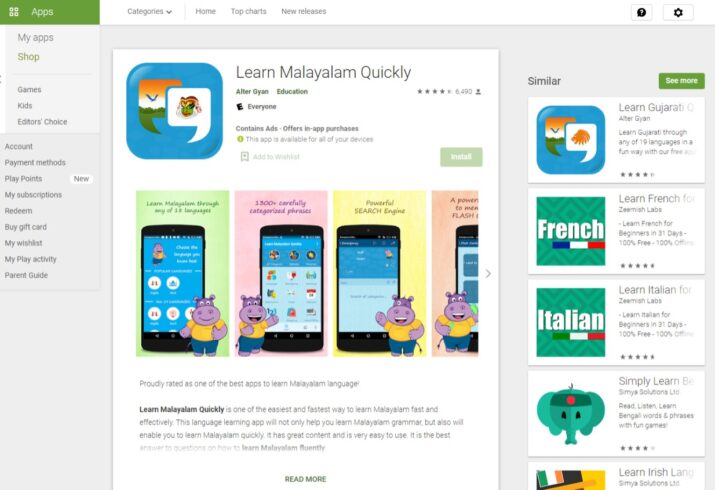
o) Learn-malayalam.com
The site features audio, video, images, and text to introduce key features of Malayalam such as vocabulary, pronunciation, etc. You can try all these for an enriching experience.
The tool aims to teach and let you practice basic conversational skills but also Malayalam culture through image galleries which include photographs from recent events and festivals taken in the last few years such as Onam, Kumbha, etc. It aims to answer questions about prominent personalities in the blog.
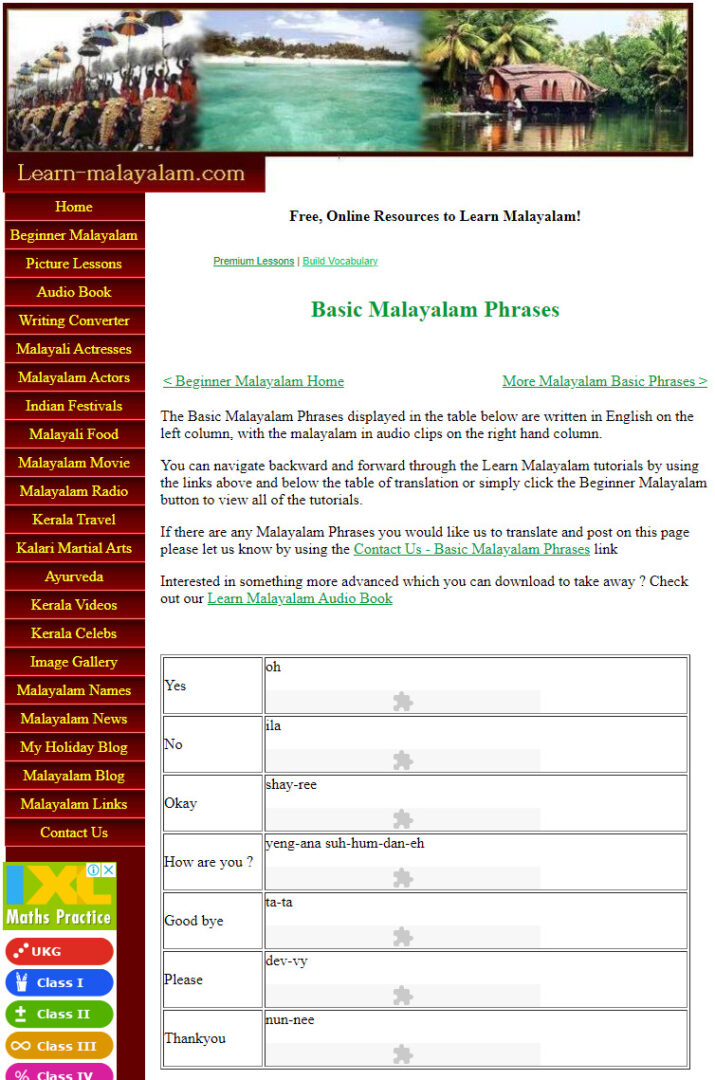
p) Kerala Kala Samskarika Vedi
This site has invaluable information on Kerala culture. The site also helps those who want to master Malayalam as they can listen to the pronunciations by clicking on the letters below each word or its meaning.
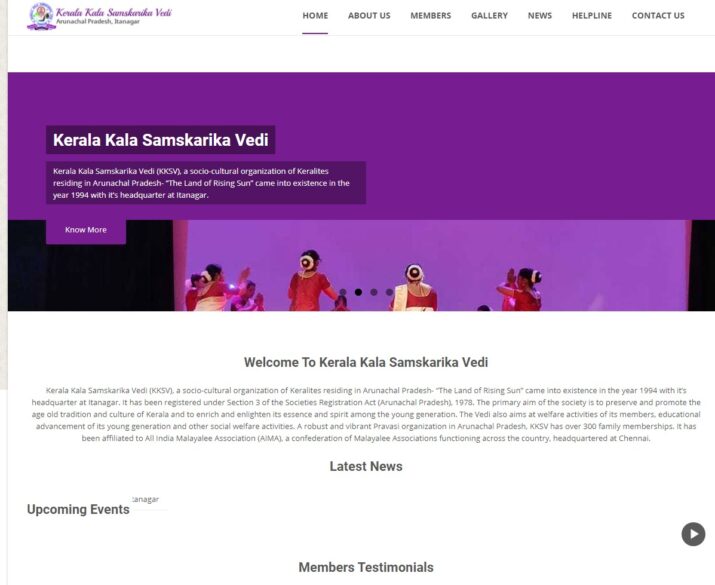
q) Quizlet
The easiest way to grasp any subject is by making your own flashcards and quiz yourself with them because you don’t need anyone, and it’s very easy to do with the Quizlet tool.
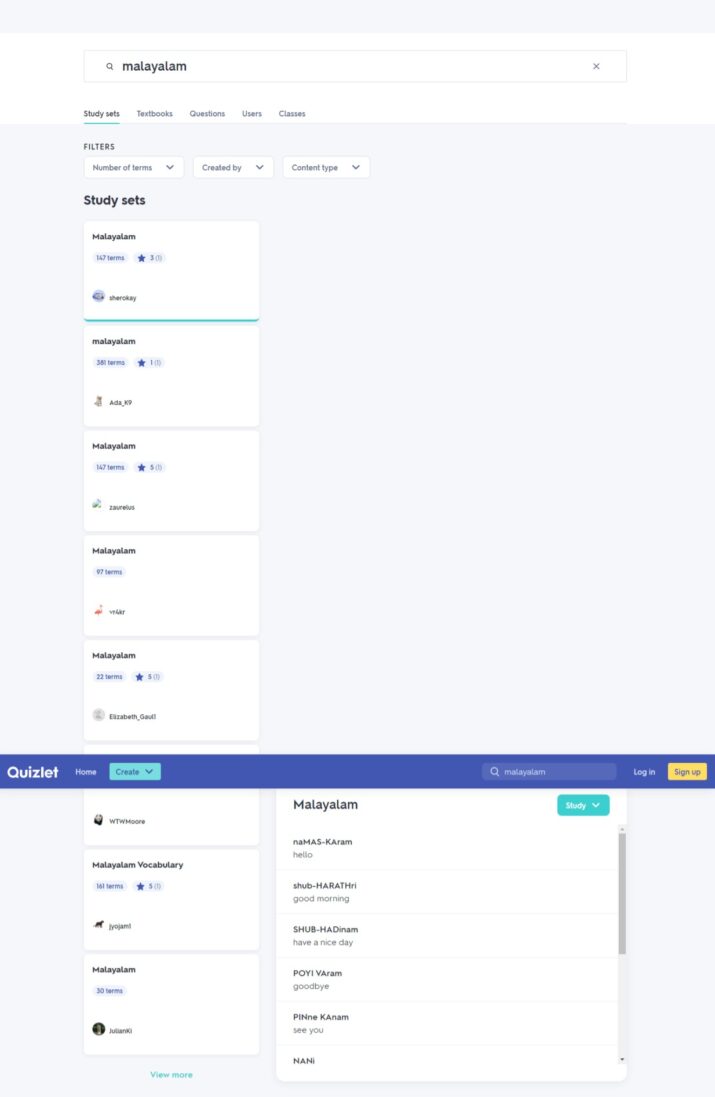
r) Online Malayalam dictionary
There are multiple instances where a user might not be comfortable with finding or spelling out words from their regional dialect to other dialects. This site will help you find the word you are looking for and greatly benefit from it. (Unpaid service).
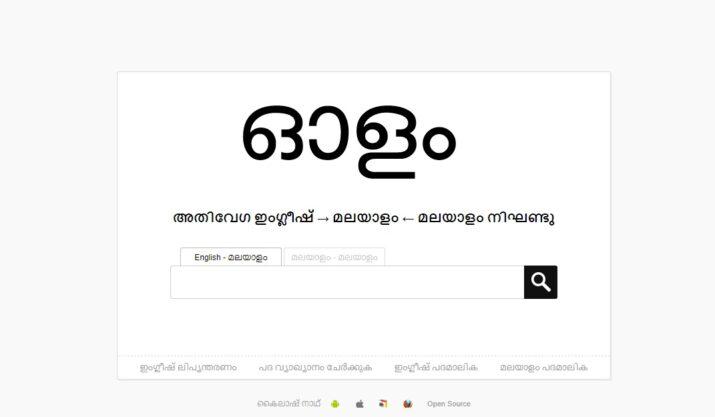
2. If you need authentic books, then there are some major publishers who provide them at reasonable prices.
—Books on Amazon India: The best way to search for books in Malayalam is through using the “Customers who bought this also bought” feature of the Amazon India store.
It gives good recommendations as well. However, keep in mind that there are very few books available for sale with descriptions.
—Learn the Malayalam in 30 days: This book has various easy-level exercises aimed at helping students without prior knowledge of the script start with their first steps in learning Malayalam.
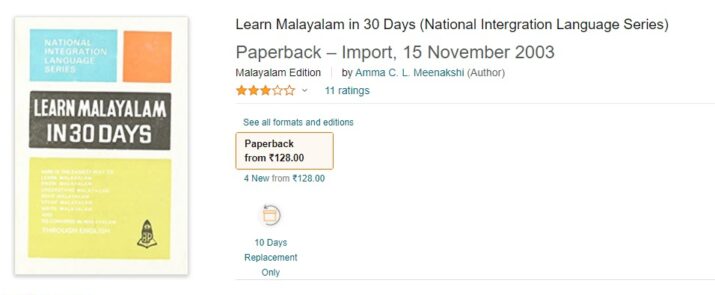
These are not boring exercises but are aimed at having fun in learning.
—Ariya Publishing House: This publishing house provides a series of books called ‘Ariya Easy Learning Series,’ which have Malayalam learning materials with pictures and audio clips in them.
Although these books are generally meant for children, they will also be effective for learners because of the book’s writing.
— Kerala Book Store: This online book store have various books having essential exercises to grasp Malayalam. It has more than 10 000 books, including ebooks, audiobooks, and paperback. It also has a home delivery option.
—Bommarillu: The author ‘Uday Krishna’ has authored a number of exclusive books on different dialects, under this series of two names. This is one such book that might help you in learning Malayalam.
—Kerala Sahitya Academy: You can find most of the Malayalam books here. They have a website where they provide information about all published books by them.
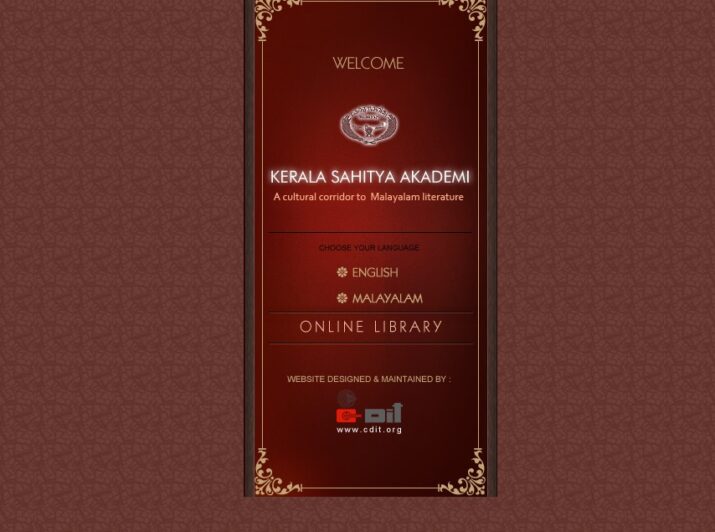
It also contains useful information about recently released movies and new movie releases, as wells as links to book stores in Kerala and other Indian states, which sell these books.
—Chandrika Book Centre: This is the best place for finding old classics as Chanthu Ramakrishnan’s “Neelakuyil,” M T Vasudevan Nair’s “Randamoozham” or Vaikom Muhammad Basheer’s “Pathini.”
—Oxford Bookstore: It is a good one to find some books related to Malayalam Literature.
3. Also, there are various audio-visual materials ‘ CDs, DVDs, Youtube channels, etc.’ that can be purchased from big-name stores or through online mediums.
—Malayalam Audio and Video: A lot of websites offer downloadable audio and video course files of dialogues for free, which you can play using your media player.
Downloadable E-books are also available on these sites (try Google Books). The main advantage of these e-books is that you can choose the typeface, background color, page size, etc., and read at leisure on your screen or print it out to read the hard copy as well.
Apart from online resources, there might be a book store near you selling books to grasp Malayalam. The drawback of this approach is that it takes more time than online methods do because the pace at which you pick up is limited by the speed at which you read or listen to these books. But the advantage of using this approach is that you can start reading a book without much preparation.
—Audio, Video Course, Apps, and Text Files Downloadable for Offline Use: A non-profit organization called Bhasha Jyothi runs an educational website where you can download audio, video course files along with text files in pdf format from their website at no cost whatsoever that you can try.
— Mayur Publications (Learning Malayalam Book + Audio Book CDs): This publication house is one such major publisher that provides authentic products in the market. The package consists of a soft copy and 3 Audio CDs that you can try
—Amazon Music: You can try to place your order online on apps for any kind of authentic audiovisual materials related to this subject at a very reasonable cost.
4. You can also ask for some tutoring classes in your known language
–Some colleges teach Malayalam as their second mainstream language, so it will be easy to find someone who would teach you for a reasonable cost
–Malayalam is taught as the second option in various countries. So it will be easy to find someone who would teach you for a reasonable price through sources like Craigslist or from your local colleges. Most of them will be able to teach and help you grasp very basic things easily and cost-effectively.
5.Online Forums:
You can also try online forums of apps where there are a lot of Malayalam teachers available to teach; who might be willing to help learners without any charges at all.
6. You can visit Kerala and spend some time there learning it from locals there:
Kerala is an amazing place that has beautiful beaches, hill stations, wildlife sanctuaries, and tea gardens, apart from various other places of tourist interest. If you want to master Malayalam or live as a family to the locals there, you can have a great experience visiting it.

Think about it; when you travel there, you can pick up directly from local speakers there. There is no better teacher to teach than the one who has grown up speaking it and is completely immersed in it.
If this is not possible, then try to find someone else with whom you would be able to spend time with at least 2- 3 hours daily. Such exposure will definitely help you develop an interest in Malayalam.
Useful experience shared by a learner
Malayalam is considered as the easiest Indian language to apprehend. After learning how to read, I learned how to speak it first within a week or so.
It is not difficult for one who knows English and Hindi as both these languages have similarities with Malayalam. Its grammar is easy and can be easily understood by those who are familiar with other modern Indian languages such as Marathi, Gujarati, Kannada, etc.
The best way to start with Malayalam is to take advantage of the online video course available on Youtube, and also try reading the Wikipedia page in Malayalam, which will give you an idea of what different things would be helpful for furthering your venture into this beautiful-sounding but a complex dialect.
Learning Malayalam has opened up a new world of cultural discovery, and through this medium, one can have the chance to interact with different guys from various backgrounds and also make some good friends.
The best thing about Malayalam is that though it is extremely difficult to learn, for those who want to put in the time and effort can get started learning it almost immediately.
Learning resources for beginners
The following links lead to some useful resources that would help you pick up Malayalam:
If you want to learn either on your own or as a class, then google, apps can prove very helpful. There are free resources/apps available on the internet, but I strongly recommend purchasing at least a book with a good dictionary. That will make all the difference. You can also try using CDs/apps as well.
Though youtube is very popular these days and contains course tutorials in various languages, but nothing beats a proper textbook for reading and writing skills.
It is difficult to find authentic printed materials online, though there are sources that provide them at reasonable prices. Audio-visual materials ‘ CD’s, DVD’s, Youtube channels, etc.’ can be purchased from big-name stores or through online medium.
Even though there are learning resources available for this, students who want to learn might require a tutor to teach; who is familiar with the basics. There are free forums where experts would help students who want to learn, without any charges at all.
Malayalam classes can also be taken from your local colleges (anywhere else). There will be no need to pay extra bucks if you want to get yourself a decent Malayalam t-shirt with an authentic logo or a mug that will remind you of this beautiful language every time you have your coffee. It will definitely be worth it.
If you live in Kerala and want to grasp Malayalam, then I strongly recommend you to join a Malayalam Speaking class in your area. The best way is to learn the basics from an individual and then to apply it by speaking that language with someone who has been using it for a long.
But due to lack of time, it might be difficult for one to find such guys nearby. So I recommend taking up some classes at your local colleges.
Top 10 phrases in Malayalam that you must know before you travel to Kerala
Dravidian origin words are used extensively for various terminologies related to day-to-day life, such as names of food items and utensils, topography, time, etc., which forms more than 80% of all common phrases in the language.
If you want to know some really cool Malayalam phrases that will be very handy to say at someone’s house or while ordering in restaurants or grocery stores when you travel, then we’ve got just the list for you.
Here’s the list of the top 10 phrases and words in Malayalam.
1) “Vellakkala” – (language)- Literally means ‘ tender coconut,’ which is used to refer to the Malayalam as well as local speakers.
2) “Ponnaniirunnu” – Playfully say when someone offers you an item out of multiple choices (literally means “take it,” but can be loosely translated as “it’s all yours”).
Also popularly used as a suffix for youthful pejorative names as “Kaniirunnu” (for Kani or Kanikka), “Chathuriyonniirunnu” (for Chathriya or Chathriyar).
3) “Nee Kochi?” – A question used to ask about the place you are currently in. Roughly translated as “This is where?/Where am I?”.
4) “Oli Oli” – An exclamation used when someone mentions something just at that moment, and you happen to agree with him/her suddenly. It literally means, ‘yes yes.’ It can also be used sarcastically.
5) “Oru mookamoru poyatha” – A humorous question that is asked to someone who keeps on ‘ whining’ about something. It literally means, “Are there mosquitoes in that place?”.
6) “Kannan” – A term used to address a person by his/her name. The suffix “an” can also be added at times. It can be loosely translated as Sir or Ma’am.
7) “Aa biryani..?” – Used to ask if someone feels like eating biriyani for lunch or dinner. It can also be used as an exclamation when you feel like having biriyani even though you already had it recently.
But just say it with the intonation of a question and not as a statement. (Biryani in Malayalam is “Perunna biriyani” or simply “Biryani”.)
8) “Ayaa kodiye..?” – A question used to ask if someone wants to come with you. It literally means, ‘shall we go?’. (you can also say it as a statement).
9) “Imme and” – Used when you have an opinion about something. An equivalent of saying, let me think about it or hold on a moment.
10) Malayalee – The word used for describing someone who’s from Kerala. It literally means the one who speaks/talks in Malayalam.
You can also call yourself a ‘Malayalee’ by adding the suffix “-an” (like “Malayalee-an”) to your name.
Conclusion
Malayalam is an ancient and beautiful South Indian Dravidian language. It has a rich cultural heritage that can be traced back to the 2nd century BC. Learning this intricate tongue will allow you access to one of India’s most prolific states, Kerala, which is home to lush forests, beaches with pristine waters, and other natural wonders. We hope these tips have been helpful in your journey towards learning Malayalam.
F.A.Q.
How To Learn Malayalam?
1. Learn how to pronounce Malayalam letters and words correctly
2. Read some basic conjugation rules
3. Get good audio or video course (if you can’t find one, make one)
4. Read non-technical books to build your vocabulary base, get used to reading the script, and practice writing sentences as much as possible from day 1.
5. Practice, practice, practice… think, read and start writing.
6. Go out with a native speaker and try to think/listen/read/write as much as possible.
How To Learn the Malayalam Language For Kids?
1. Teach Them In Their Native Language
The alphabet used in the Malayalam language uses certain sounds which can be challenging for plenty of speakers. When reading out certain words, it will sound out of place to an English ear. You can help your child perceive the new language better when you teach them in their native tongue.
You can use flashcards that include an illustration on one side and the abbreviation for the word on the other.
Cut out pictures from magazines or print Malayalam words from newspapers so that they can match them with the picture cards.
They will enjoy all these activities but it also helps you gauge how well they are grasping what you are trying to teach them. This is especially important if this is something you plan on doing multiple times before they fully grasp everything you have been teaching them.
2. Sing Nursery Rhymes And Children’s Songs In Malayalam
The best way that children learn is by repetition and if they hear a song in their native language with family, it can be easy to pick up some of the words used.
The next step would be to use the same nursery rhyme or children’s song but recite it using the Malayalam vocabulary which can help your child understand how sentences flow differently in another language compared to their own.
This is also beneficial for helping kids identify different sounds and pronunciations of words better as there is an association with the familiar song.
3. Get A Child’s Picture Dictionary
You should get a picture dictionary which has photographs of animals, objects, and people as well as the different things that they use in everyday life. This will help your child not only learn new words but it will also give them an insight into what daily life is like outside of their immediate surroundings.
Keeping this book on a shelf where they can easily access it when needed will help them associate pictures with words better and quicker.
When you find out that something is wrong or that there is something that they have difficulty pronouncing, encourage them to look up the word and pronounce it correctly to see if they get the correct pronunciation and inflection right.
As you are doing this, be sure to show how interested you are in what they are doing by listening carefully as well as provide encouragement for anything positive that happens during these moments.
The post Learn Malayalam Yourself: Useful Experience Shared appeared first on Dumb Little Man.
0 Commentaires